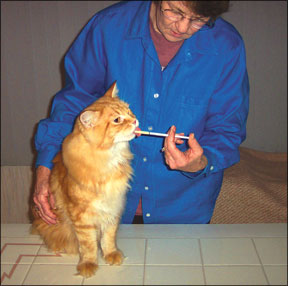Pinch your finger in a car door, step on a nail or cut your thumb while peeling an onion, and youre apt to let out a holler that will alert everyone within hearing range to the fact that youre experiencing pain. And then youll spend the next week or two talking about that dreadful moment and its unpleasant consequences. Your cat is much different from you in that respect. Certainly, it can experience discomfort of varying intensity in its hard and soft tissues – its bones, joints, Bev Caldwell 288 ligaments, muscles and internal organs. And it may howl for a moment when it senses sharp pain. But it certainly wont verbalize. It wont be able to point pathetically to a lacerated paw pad or an aching joint and say, “This is where it hurts!” 
Clear Indications
Then how can we tell that a cat is in pain? According to Andrea Looney, DVM, a lecturer in anesthesiology at the Cornell University Hospital for Animals, “We look at two categories of clinical signs – physiologic and behavioral. The physiologic signs include such indicators as heart rate, temperature, respiratory rate, blood pressure and the levels of certain stress hormones in the blood.
“But these indicators are not as reliable as the behavioral signs,” she continues. “Each cat is an individual, and we try to look at how they normally behave and how that behavior is different when they come in with complaints. If the behavior has changed substantially, were likely to assume that the animal is in pain. Observing these signs can sometimes present a challenge, since cats, unlike dogs, tend to be very good at concealing the fact that they are in pain and are, therefore, vulnerable. This is part of their natural survival instinct.”
To assess a cats behavioral changes, says Dr. Looney, “We try to fish out details from the owner about very subtle characteristics – its typical eating and grooming habits, its normal sleep patterns, its use of the litter box, the way it typically interacts with people and with other cats.” Possible behavioral signs of feline pain include:
- Abnormal posture (tenseness, hunched-up position, atypical lying-down position, long periods of lying quietly)
- Abnormal gait or movement (stiff gait, apparent difficulty in rising or sitting, circling, guarding of body parts)
- Vocalization (screaming, whining, hissing, moaning)
- General behavior (persistent rubbing or licking on a specific area of the body, agitation, altered sleep pattern, inattention to grooming, unusual litter box activity, aggression or apparent fearfulness, avoidance of interaction with humans and other animals, decreased appetite or picky eating).
Although pain may cause any of these behavioral changes and dozens of others as well, they may also be exhibited by cats that are healthy, happy, and not in pain. The signs must therefore be considered in the context of what is normal for the individual cat.
Call to Action
Unpleasant as it is, pain can play an important role in maintaining a cats health and well-being by alerting its brain to the sad fact that something, somewhere in its body, has gone awry and needs attention. This protective mechanism is enabled by sensitive receptor cells located throughout the body – in the skin, the bones, joint surfaces, artery walls, just about everywhere. These specialized cells, stimulated by harmful forces or substances (pressure on a limb or internal organ, extreme heat or cold, the consumption of a poisonous substance or inflammation in a joint, for example), transmit electrical impulses along nerves to the spinal cord and then to the cats brain.
“The initial five or 10 minutes of pain can be life-saving in certain situations,” Dr. Looney points out, “due to increased cardio output, certain muscle reactions and the triggering of the fight-or-flight instinct that will prompt a cat to get away from the source of the pain. But if the pain persists past an hour or two, it has no positive effect. It becomes a pathologic situation.”
Types of Pain
Like human pain, she notes, feline pain can be acute (or maladaptive) – the kind of intense but comparatively short-term discomfort that may be caused by, for example, a bone fracture or burned skin. Or it can be chronic (or adaptive), persisting constantly or intermittently for an extended period, even a lifetime, as a gradually intensifying byproduct of an injury or long-standing physical disorder.
Common causes of acute pain include surgical procedures, broken bones, abscesses and a variety of traumatic injuries that cats typically suffer in car accidents and fights with other animals. As for the most frequently diagnosed sources of nagging chronic feline pain, Dr. Looney cites joint disease (especially osteoarthritis), heart and lung disease, pancreatitis, urinary tract infections, gastrointestinal disorders, such as inflammatory bowel disease, and abscesses. “These conditions develop and progress over long periods of time,” she says, “and can be hugely overlooked by owners.”
Easing Discomfort
Currently, feline pain is treated primarily with two types of analgesics: opioids, which function as numbing agents that dull pain, and nonsteroidal anti-inflammatory drugs (NSAIDs), which reduce inflammation. A veterinarian will select a painkiller that is appropriate depending largely on the source of the pain, the intensity of discomfort and the length of time that is prudent and desirable for an animal to be given the drug. Some pain-relieving medications that have been formulated for humans (such as Tylenol) can be fatal to a cat and must never be used to treat feline pain.
If your cat seems to be in pain, advises Dr. Looney, “Dont just assume that it has stubbed its toe and forget about it. And dont give it any pain relievers without consulting your veterinarian. Palliating pain is never the cure – we have to find the source and treat it.” v



